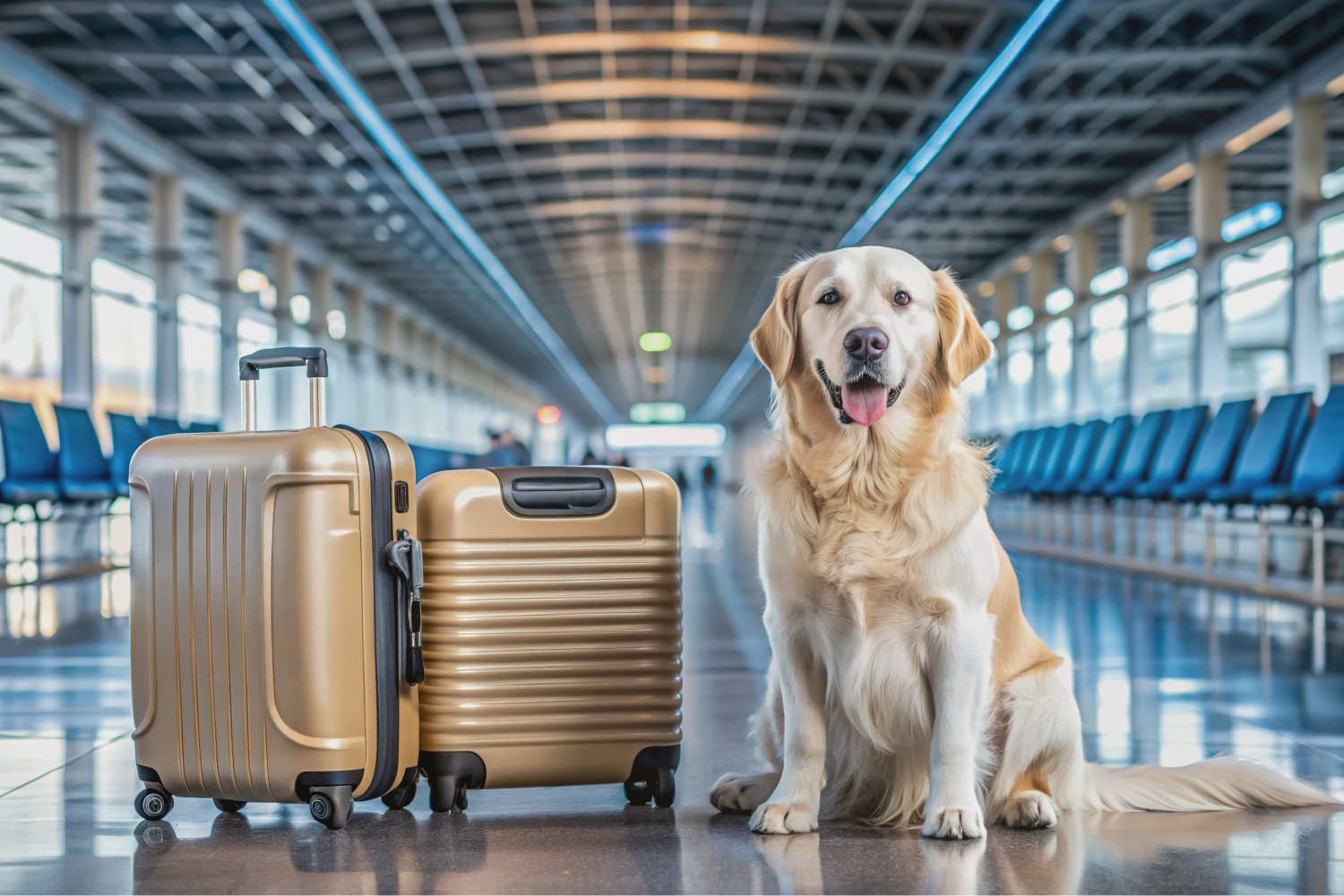
BOGO: buy a box of Longevity15 and get Yummy Combs free!
Shop now and get the BOGO deal today!
Joseph Roetheli, PhD

Highlights:
Flying with your dog can be stressful. Researching the right airline for your large-breed dog can help reduce the stress.
Your dog will need certain amenities while they fly, just like you. Check with your airline to be certain you’ve packed enough food and “toiletries.”
When the flight is over, offering your dog a Yummy Combs® treat can be a satisfying reward that doubles as dental care.
Each year, millions of us jet-set across the country or international waters to do business, visit family, or indulge in a vacation. While many people are comfortable flying with their toy-sized chihuahuas or miniature dachshunds, owners of large-breed dogs may face uncertainty as to whether or not they’ll even be allowed to carry their dogs with them on a flight.
The fast answer to that question is yes, you can fly with a large-breed dog, but different rules apply and, of course, your dog won’t be able to sit on your lap or hide discreetly in a cute carrier beneath your seat.
We’ll tell you what to expect when flying with your dog and give you the information you need to make an informed decision about their care.
Before your dog can fly, you’ll need to ensure they are up-to-date on their vaccinations and have a health certificate printed from their veterinarian within 10 days of the flight. This certification states they have been vaccinated and screened for disease and are deemed healthy to fly.
Each airline has different policies regarding health screenings, but as a general rule, you won’t be able to board (nor should you risk your dog’s health) if your dog is actively ill. When you visit your dog’s veterinarian, it is also important to discuss your dog’s overall health and whether or not they should fly.
The airport environment and the airplane itself can be very stressful for dogs, and your dog’s veterinarian can tell you if flying is a good idea or not. In some cases, a veterinarian may prescribe a sedative to help relax your dog on the flight.
Getting your dog through the airport can be a chore, but most larger airports have dedicated dog relief areas to help make the process easier. When you are ready to check in, head to the ticketing counter, where you will either check your dog in as cargo or checked baggage. Most airlines require dogs over 20 pounds to be crated and ride in the cargo or checked baggage hold during flight.
Some airlines allow travelers to purchase a seat for their furry travel companions. United Airlines, for instance, will allow travelers to bring two pets onboard, provided they buy an additional seat. This does not, however, apply to large-breed dogs. On every airline that allows large-breed dogs, the cargo hold is the method of transport.
Once you have thoroughly reviewed the airline’s policy, choosing your dog’s travel crate is the next step. You’ll want a durable crate that is airline-approved.
Check your airline’s policy to determine the parameters necessary for the crate. American Airlines, for instance, requires animals to be able to stand in their crate with enough space that their ears and tails do not touch the edges of the crate.
Inside your dog’s crate, you’ll need to have blankets for comfort, a pee pad in case they need to relieve themselves, and two water dishes. The first water dish should have fresh water, and the other should be empty and available for ice cubes, which are sometimes given to animals before takeoff so that they have access to water for the duration of the flight.
It’s important to avoid feeding your dog at least four to six hours before takeoff. This reduces the need your dog will have to pee or poop in flight. If you are on a long flight or a flight with a layover, airline personnel will feed your dog and allow them to relieve themselves in designated airport locations.
If you are on a long flight or one with a layover, you’ll need to pack food for your dog to eat during this break. Check with your airline to get the specifics about how much food to pack and when your dog will be fed.
If you have a connecting flight, your dog will be sent to the connecting aircraft just like your luggage. Don’t worry. It is extremely unlikely your dog will be lost like luggage frequently is! Airlines have far fewer “checked pets” to transport between airplanes, and there is typically a dedicated team responsible for moving pets between aircraft.
If at all possible, it’s best to try to get a direct flight. A direct flight is less stressful for your pet (and probably you). However, if you have a very long flight (over 12 hours), consider booking a connection so your dog can be released from the kennel to potty and stretch their legs.
A flight can be even more stressful for a dog who is typically in a large yard or moves freely about the house during the day. Before you head to the airport, take your dog for a long walk, throw the ball, or go for a run. The additional exercise can help keep your dog relaxed and encourage them to sleep during flight, reducing the amount of stress your dog experiences.
Traveling can be stressful for both you and your animal, but airlines are well-equipped to handle your pet’s travel needs. Ensuring your safety and the safety of your pet is the top priority, and the airline has procedures in place to make sure that animals are safe. Even though you may worry that your large-breed dog will have a bad experience, many animals travel better than their human owners.
When you arrive at your destination, giving your dog a big hug and offering some treats is a great way to reassure them that the hard part is over.
Longevity15 is the first and only supplement available for dogs with pentadecanoic acid or C15:0. C15:0 is an odd-chain, saturated fatty acid that is the first essential fatty acid discovered since the omegas over 90 years ago.
C15:0 helps support your dog’s heart health and liver function by targeting their cells. C15:0 deep dives into cells to keep them supported, which helps support your dog’s entire body.
C15:0:
The C15:0 in Longevity15 helps support your large dog’s overall wellness and is one of the smartest moves you can make to help your dog live a healthy life for longer. Best of all, it comes free of side effects and won’t ever give them any fishy breath. That means fresher breath and more close cuddles.
When you’re ready to jet set with your pet, know that the airline you choose has you and your pet covered. With the right crate and the right flight, you can enjoy traveling with your pet from coast to coast or even overseas.
When you arrive, be sure to give your dog a treat for a job well done, and treat yourself to a drink in the airport lounge. You’ve earned it.
Sources:
Airline Pet Policies: A Guide to Dog Travel Requirements for Flying
Kennel Guidelines – Pets & Animals | American Airlines Cargo
Relation between periodontal disease and systemic diseases in dogs | ScienceDirect
Updates, coupons, deals, and more!
Type anything...
We use cookies to provide you the best possible experience on our website. You consent to the usage of cookies by continuing to view our website. See our Privacy Notice for more information.